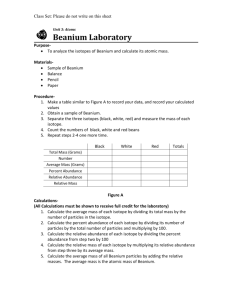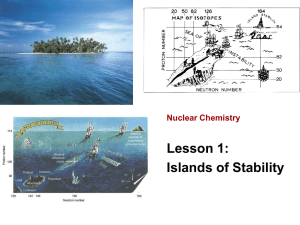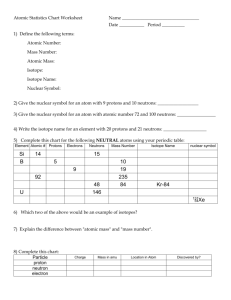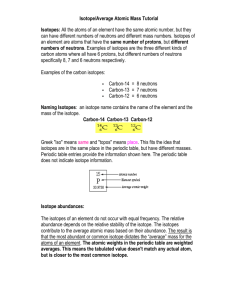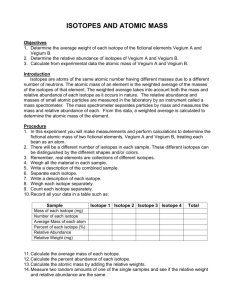Isotopes Computer Simulation
advertisement
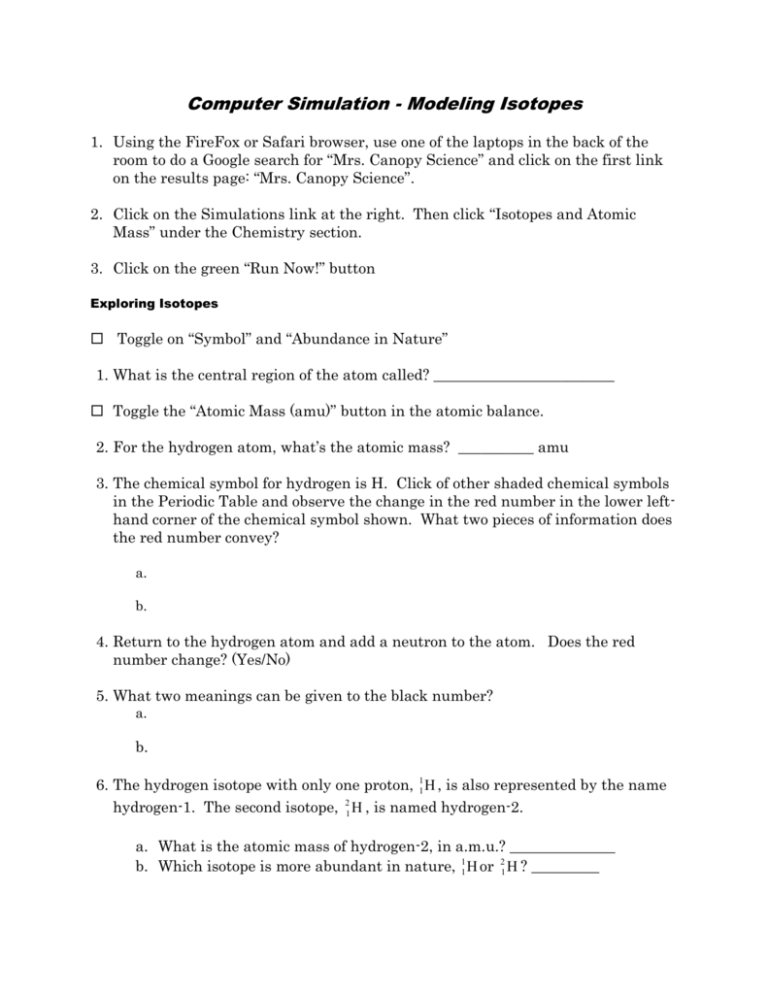
Computer Simulation - Modeling Isotopes 1. Using the FireFox or Safari browser, use one of the laptops in the back of the room to do a Google search for “Mrs. Canopy Science” and click on the first link on the results page: “Mrs. Canopy Science”. 2. Click on the Simulations link at the right. Then click “Isotopes and Atomic Mass” under the Chemistry section. 3. Click on the green “Run Now!” button Exploring Isotopes Toggle on “Symbol” and “Abundance in Nature” 1. What is the central region of the atom called? ________________________ Toggle the “Atomic Mass (amu)” button in the atomic balance. 2. For the hydrogen atom, what’s the atomic mass? __________ amu 3. The chemical symbol for hydrogen is H. Click of other shaded chemical symbols in the Periodic Table and observe the change in the red number in the lower lefthand corner of the chemical symbol shown. What two pieces of information does the red number convey? a. b. 4. Return to the hydrogen atom and add a neutron to the atom. Does the red number change? (Yes/No) 5. What two meanings can be given to the black number? a. b. 6. The hydrogen isotope with only one proton, 11 H , is also represented by the name hydrogen-1. The second isotope, 21 H , is named hydrogen-2. a. What is the atomic mass of hydrogen-2, in a.m.u.? ______________ b. Which isotope is more abundant in nature, 11 H or 21 H ? _________ Write the chemical symbol of a hydrogen atom with two neutrons: _________ c. Build the atom. Is this atomic nucleus stable? (Yes/No) Note: Unstable nuclei are radioactive; that is, they undergo nuclear change by emitting subatomic particles and radiant energy. d. How is the natural abundance of this isotope in nature described? e. What is other name can be given to this third isotope? _______________ 7. Add a third neutron to the hydrogen atom. a. What is the chemical symbol of this isotope?_______ b. Is this isotope stable? (Yes/No) c. Do you expect this isotope to be radioactive? (Yes/No) d. What is the reported natural abundance of this isotope in nature? ___________ 8. Add a fourth and fifth neutron to the hydrogen atom. What can you conclude about the stability and abundance of these and other more massive hydrogen atoms? 9. Click on the helium (He) chemical symbol in the Periodic Table. Remove the two neutrons by dragging them to the neutron bin. a. What can you state about the stability and abundance of 22 He ? b. Write the chemical symbol of the isotope containing two protons and one neutron: _________ c. Build the atom by dragging a neutron and placing it in the nucleus of the atom. i. Does adding a neutron help stabilize the helium nucleus ?(Yes/No) ii. Do you expect this isotope to be radioactive? (Yes/No) iii. What is the reported natural abundance of this isotope in nature? ___________ iv. What is the name of this isotope? ___________________________ 10. Complete the following data table: Table 1. Possible helium isotopes Isotope Atomic Number Isotope Symbol # neutrons (p) Mass Number Radioactive? (Y/N) Natural Abundance (p+n) Helium-3 Helium-4 Helium-5 Identifying stable and natural radioactive nuclei and their relative abundances: 11. Survey the first ten elements. Write the chemical symbol, name and the natural abundance of all stable isotopes. If you identify a radioactive isotope with “very small” natural abundance, list its chemical symbol and name. Hydrogen Helium Lithium Beryllium Boron Nitrogen Oxygen Fluorine Neon Chemical symbols of stable isotopes 1 1 Isotope names and relative abundance Chemical symbol and name of natural radioactive isotopes 2 1 H hydrogen-1 (99.9885%) hydrogen-2 (0.0115%) 3 1 H hydrogen -3 Carbon Chemical symbols of stable isotopes Isotope names and relative abundance Chemical symbol and name of natural radioactive isotopes H




